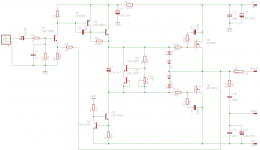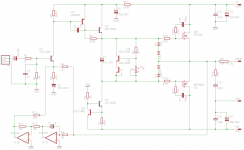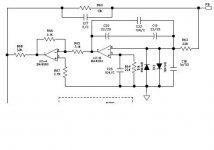Member
Joined 2009
Paid Member
Hi Bigun or others,
How does one change the .asc extension to something useable. I managed to change the .asc to mp3 when listening to audio files posted in another thread, but I am having trouble with your file in #721. Thanks for the help.
Myles
How does one change the .asc extension to something useable. I managed to change the .asc to mp3 when listening to audio files posted in another thread, but I am having trouble with your file in #721. Thanks for the help.
Myles
I have built a circuit very similar to TGM8 before with a simple servo. It was TGM3 (there's a thread on it around here somewhere). In that design I made a DC servo using a single transistor and it worked OK but produced some delayed turn-on noises - a servo needs to have a long time constant. Bob does say you have to design a servo well to avoid impacting the sound. I thought the present arrangement might have some benefits. But if we wanted, we could readily re-spin the design with a servo. I have another design for a single transistor servo that I prefer to that which I used in TGM3 - too many ideas and too little time !
Hi Bigun
Would you mind sending me details of the servo design you referred to here?
I have an idea for an adaptation of TGM8 incorporating HEXFET outputs driven from a SE buffer stage, with a low power VAS bootstrapped from the buffer. I'm not a fan of trimpots and would like to deal with thermal drift DC offset errors once and for all, so the servo approach holds some appeal.
I put together a quick schematic to illustrate the concept. Input biasing has been omitted but you should get the basic idea.
What we have is a HEXFET complimentary output pair with low resistance gate stoppers to keep the speed up, and with gate-drain zobels to tame oscillation. I love these little TO-220 packaged HEXFETs; they definitely punch above their weight and have survived abusive testing I've subjected them to that have killed much bigger bipolars.
The gates are driven from a single-ended buffer stage, which should help promote "nice" distortion. I do very much like simple bootstrapped current sources, particularly as a VAS load, where the reduced impedance at high frequency can help compensate the amplifier by reducing gain. Here I have loaded the buffer with an active current source to keep the impedance up at high frequencies, where is needed most to drive the gate capacitance of the MOSFETs.
The VAS is bootstrapped to the buffer and has high Zin and good amount of gain.
You will note that there is no feedback cap and I'm hopeful that with a good DC servo (and reliable speaker protection at the output) that it will be unnecessary.
What we have is a HEXFET complimentary output pair with low resistance gate stoppers to keep the speed up, and with gate-drain zobels to tame oscillation. I love these little TO-220 packaged HEXFETs; they definitely punch above their weight and have survived abusive testing I've subjected them to that have killed much bigger bipolars.
The gates are driven from a single-ended buffer stage, which should help promote "nice" distortion. I do very much like simple bootstrapped current sources, particularly as a VAS load, where the reduced impedance at high frequency can help compensate the amplifier by reducing gain. Here I have loaded the buffer with an active current source to keep the impedance up at high frequencies, where is needed most to drive the gate capacitance of the MOSFETs.
The VAS is bootstrapped to the buffer and has high Zin and good amount of gain.
You will note that there is no feedback cap and I'm hopeful that with a good DC servo (and reliable speaker protection at the output) that it will be unnecessary.
Attachments
Servo added...
Hi guys
I realised that removing the feedback cap is a futile exercise with this topology, because with the IP emitter bias fixed to 0V, an offset voltage must be present at the base, which will be amplified without the cap in place, so back in it goes...
Gareth has a 470u cap here in series with a 56R shunt resistor, putting the corner frequency at 6 Hz; a little too high for my taste where an electrolytic is used. I doubt that it is going to make an audible difference, but since I'm revisiting this project I might as well experiment. I've increased the size substantially to reduce distortion while keeping emitter degeneration low to keep the loop gain up.
Most people seem to agree that the most suitable gain devices for a DC servo are JFETs, since they have almost no gate current draw. Unfortunately there seem to be very few JFETs available these days, fewer still in through-hole, and they are expensive relative to their bipolar counterparts. On the other hand, the TL072 JFET opamp is commonplace and inexpensive. In fact I have a rail of them that I bought a while ago for peanuts.
Its annoying that extra components are needed to bring down the rail voltages, but then most discrete JFETs have low breakdown voltages too, so these components would be needed anyhow.
So here it is... keen to hear people's comments, and I'll wait a few days before starting the layout to see whether anyone has any suggestions.
Hi guys
I realised that removing the feedback cap is a futile exercise with this topology, because with the IP emitter bias fixed to 0V, an offset voltage must be present at the base, which will be amplified without the cap in place, so back in it goes...
Gareth has a 470u cap here in series with a 56R shunt resistor, putting the corner frequency at 6 Hz; a little too high for my taste where an electrolytic is used. I doubt that it is going to make an audible difference, but since I'm revisiting this project I might as well experiment. I've increased the size substantially to reduce distortion while keeping emitter degeneration low to keep the loop gain up.
Most people seem to agree that the most suitable gain devices for a DC servo are JFETs, since they have almost no gate current draw. Unfortunately there seem to be very few JFETs available these days, fewer still in through-hole, and they are expensive relative to their bipolar counterparts. On the other hand, the TL072 JFET opamp is commonplace and inexpensive. In fact I have a rail of them that I bought a while ago for peanuts.
Its annoying that extra components are needed to bring down the rail voltages, but then most discrete JFETs have low breakdown voltages too, so these components would be needed anyhow.
So here it is... keen to hear people's comments, and I'll wait a few days before starting the layout to see whether anyone has any suggestions.
Attachments
I don't see why you use an inverting DC servo first stage followed by and inverting second stage.
Why don't you use a non-inverting DC servo stage?
Way back we used the 411 because it had lowish input offset and lowish input offset drift.
There are hundreds of modern opamps that can beat the 411 by many decades in these two parameters. The 072 is not one of them.
Why don't you use a non-inverting DC servo stage?
Way back we used the 411 because it had lowish input offset and lowish input offset drift.
There are hundreds of modern opamps that can beat the 411 by many decades in these two parameters. The 072 is not one of them.
Last edited:
Hi Andrew
The first stage is an inverting integrator that performs low-pass filtering and gain, while the second stage is a simple unity gain inverting amplifier to put the output back in phase. The benefit of this arrangement is that it requires only one capacitor (C3) and the second op-amp comes for "free" in the common dual TL072 package that would otherwise go unused.
It is possible to build an equivalent circuit using a single op-amp but this requires a second capacitor, a ground shunt at the non-inverting input, and so the circuit cost increases, and importantly, PC board footprint (the latter is always at a premium in my layouts).
I'm sure there are op-amps that offer far better DC precision than the one I've specified. That said, I'm not terribly interested in precision operation: if it can keep the offset to within +/- 500mV under all temperatures I'll be happy, if its to within 50mV even better.
The first stage is an inverting integrator that performs low-pass filtering and gain, while the second stage is a simple unity gain inverting amplifier to put the output back in phase. The benefit of this arrangement is that it requires only one capacitor (C3) and the second op-amp comes for "free" in the common dual TL072 package that would otherwise go unused.
It is possible to build an equivalent circuit using a single op-amp but this requires a second capacitor, a ground shunt at the non-inverting input, and so the circuit cost increases, and importantly, PC board footprint (the latter is always at a premium in my layouts).
I'm sure there are op-amps that offer far better DC precision than the one I've specified. That said, I'm not terribly interested in precision operation: if it can keep the offset to within +/- 500mV under all temperatures I'll be happy, if its to within 50mV even better.
I think that TL072 is excellent for DC servo. We do not need hard to find opamps like LF411 for the purpose. In Alesis RA150 studio power amp cheap bipolar BA4560 opamp is used for DC servo and here is what I measured: Rchannel 0,3mV, Lchannel 0,5mV!
Attachments
Any PCB's for TGM8 still available?
Hello Everyone,
Is there anyone else from the UK that has built the TGM8 that has a couple of left over PCB's from a batch? Alternatively is there anyone in the process of ordering a batch or would be interested if I ordered a batch?
Thanks,
Ian
Hello Everyone,
Is there anyone else from the UK that has built the TGM8 that has a couple of left over PCB's from a batch? Alternatively is there anyone in the process of ordering a batch or would be interested if I ordered a batch?
Thanks,
Ian
Member
Joined 2009
Paid Member
The easiest one is here: http://www.diyaudio.com/forums/solid-state/250380-biguns-tgm8-single-supply.html
The easiest one is here: http://www.diyaudio.com/forums/solid-state/250380-biguns-tgm8-single-supply.html
Thanks Bigun 🙂 I am going through it.
PCB's for TGM8 available...
Hello Everyone,
I have had a batch of 10 PCB's manufactured for this amp and am very happy with the quality etc. I'd be happy to sell some of them if anyone is also wishing to make this amp. Please send me a message if interested.
Thanks,
Ian
Hello Everyone,
I have had a batch of 10 PCB's manufactured for this amp and am very happy with the quality etc. I'd be happy to sell some of them if anyone is also wishing to make this amp. Please send me a message if interested.
Thanks,
Ian
I'm interested Ian. 🙂
Shall we continue our conversation via PM? Can you tell me more about your version of the PCB?
Shall we continue our conversation via PM? Can you tell me more about your version of the PCB?
Member
Joined 2009
Paid Member
Hello all ,
I have a p3a and I like it very much but I'd love to build an improvement of it.
So someone have PCBS to sell?
Thanks
I have a p3a and I like it very much but I'd love to build an improvement of it.
So someone have PCBS to sell?
Thanks
Member
Joined 2009
Paid Member
Hi Bruno,
You can buy your own pcb's from China for less money than a hi-end beef burger. Look here: https://www.itead.cc/open-pcb/pcb-prototyping/2layer-green-pcb-5cm-x-10cm-max.html
The data files you need are all posted in this thread (I think there are details in the first post).
You can buy your own pcb's from China for less money than a hi-end beef burger. Look here: https://www.itead.cc/open-pcb/pcb-prototyping/2layer-green-pcb-5cm-x-10cm-max.html
The data files you need are all posted in this thread (I think there are details in the first post).
- Home
- Amplifiers
- Solid State
- TGM8 - my best amplifier, incredible bass, clear highs, no fatigue (inspired by Rod Elliot P3a)


